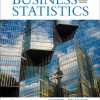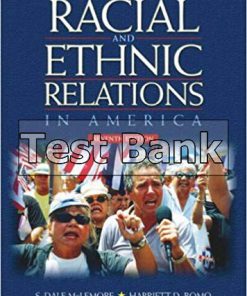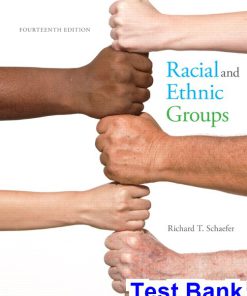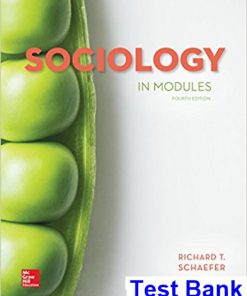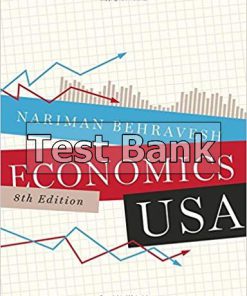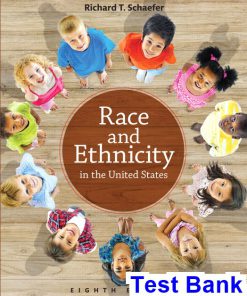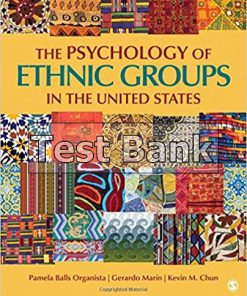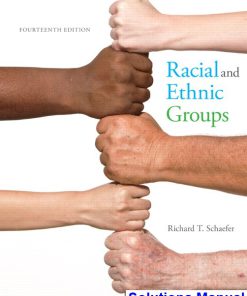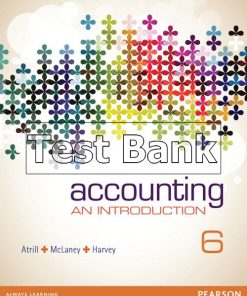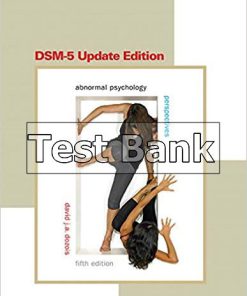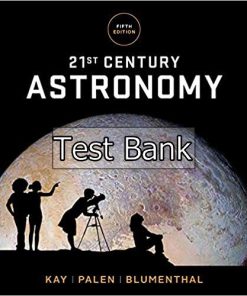Racial and Ethnic Diversity in the USA 1st Edition Schaefer Test Bank
$50.00 Original price was: $50.00.$26.50Current price is: $26.50.
Racial and Ethnic Diversity in the USA 1st Edition Schaefer Test Bank.
Racial and Ethnic Diversity in the USA 1st Edition Schaefer Test Bank
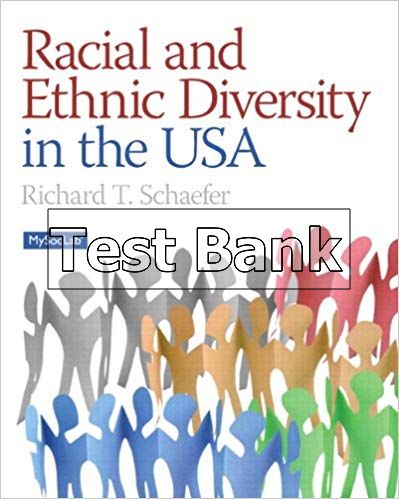
Product details:
- ISBN-10 : 0205181880
- ISBN-13 : 978-0205181889
- Author: Schaefer, Richard
Racial and Ethnic Diversity in the USA applies contemporary theories to race and ethnic relations. The text explores issues inherent in race and ethnicity and then applies these issues to the four largest minority ethnic groups in the U.S. This foundation will enable readers to discuss how diversity will change in the future.
MySocLab is an integral part of the Schaefer program. Engaging activities and assessments provide a teaching and learning system that helps students discover sociology in their lives. With MySocLab, students can watch videos on sociological core concepts, explore real-world sociology through the new Social Explorer, and develop critical thinking skills through writing.
Table contents:
1 Exploring Race and Ethnicity in the United States 1
Highlights 2
Ranking Groups 4
Types of Groups 5
Racial Groups 5
Ethnic Groups 7
Religious Groups 7
Speaking Out: Problem of the Color Line, by W. E. B. Du Bois 8
Gender Groups 8
Other Subordinate Groups 9
Does Race Matter? 9
Biological Meaning 9
Absence of Pure Races 9
Intelligence Tests 10
Social Construction of Race 11
Biracial and Multiracial Identity: Who Am I? 12
Research Focus: Multiracial Identity 13
Sociology and the Study of Race and Ethnicity 14
Stratification by Class and Gender 15
Theoretical Perspectives 15
Functionalist Perspective 15
Conflict Perspective 16
Labeling Theory 17
The Creation of Subordinate-Group Status 19
Migration 19
Annexation 19
Colonialism 20
The Consequences of Subordinate-Group Status 21
Extermination 21
Expulsion 22
Secession 22
Segregation 23
Fusion 25
Assimilation 26
The Pluralist Perspective 27
Resistance and Change 28
2 Prejudice 33
Highlights 34
Prejudice and Discrimination 35
Merton’s Typology 36
LaPiere’s Study 36
Research Focus: Islamophobia 38
White Privilege 39
Theories of Prejudice 40
Scapegoating Theory 40
Authoritarian Personality Theory 40
Exploitation Theory 41
Normative Approach 41
Stereotypes 42
What Are Stereotypes? 42
Speaking Out: National Media Should Stop Using Obscene Words, by Tim Giago 43
Stereotyping in Action: Racial Profiling 44
Color-Blind Racism 45
The Mood of the Oppressed 46
Intergroup Hostility 48
Reducing Prejudice 51
Education 52
Mass Media 52
Avoidance versus Friendship 54
The Social Distance Scale 54
Equal Status Contact 54
Avoidance Via the Internet 55
Corporate Response: Diversity Training 56
3 Discrimination 62
Understanding Discrimination 64
Hate Crimes 65
What Are Hate Crimes? 65
Why Do Hate Crimes Carry Harsher Penalties? 66
Institutional Discrimination 67
Discrimination Today 68
Discrimination Hits the Wallet 68
Eliminating Discrimination 71
Wealth Inequality: Discrimination’s Legacy 73
Research Focus: The Unequal Wealth Distribution 74
Environmental Justice 75
Affirmative Action 76
Affirmative Action Explained 77
The Legal Debate 77
Speaking Out: The Enduring Relevance of Affirmative Action, by Randall Kennedy 79
Reverse Discrimination 80
The Glass Ceiling 81
4 Immigration and Ethnicity 87
Patterns of Immigration to the United States 88
Today’s Foreign-Born Population 89
Early Immigration 91
The Anti-Chinese Movement 91
Restrictionist Sentiment Increases 93
The National Origin System 93
Speaking Out: Chinese Exclusion Act of 1882, by Judy Chu 94
The 1965 Immigration and Nationality Act 96
Contemporary Social Concerns 97
The Brain Drain 97
Population Growth 98
Mixed-Status Families 99
Language Barriers 99
Illegal Immigration 102
Refugees 105
Ethnic Diversity 106
Studying Whiteness 106
Rediscovering Ethnicity 108
The Third-Generation Principle 108
Ethnic Paradox 109
Symbolic Ethnicity 109
Religious Pluralism 110
Research Focus: Blended Identity and Self-Identifying as “Muslim American” and “Arab American” 111
5 Native Americans 119
Early European Contacts 121
Treaties and Warfare 122
The Allotment Act 123
The Reorganization Act 124
Reservation Life and Federal Policies 125
Legal Claims 126
The Termination Act 127
Employment Assistance Program 127
Collective Action 128
Protest Efforts 129
Collective Action: An Overview 130
American Indian Identity 131
Sovereignty 131
Individual Identity 132
Native Americans Today 132
Speaking Out: Powwows and Karaoke, by Chris Eyre 133
Economic Development 134
Tourism 135
Casino Gambling 135
Education 137
Research Focus: Learning the Navajo Way 138
Healthcare 139
Religious and Spiritual Expression 140
Environment 141
6 African Americans 145
Slavery 147
Slave Codes 147
The Attack on Slavery 148
Slavery’s Aftermath 149
Reflecting on Slavery Today 150
The Challenge of Black Leadership 151
The Politics of Accommodation 151
The Niagara Movement 152
Reemergence of Black Protest 153
The Civil Rights Movement 155
Struggle to Desegregate the Schools 155
Civil Disobedience 156
Urban Violence and Oppression 158
Black Power 159
Education 160
School Segregation 161
Higher Education 162
The Economic Picture 163
The Middle Class 163
Research Focus: Moving on Up, or Not 164
Employment 165
Family Life 166
Challenges to Family Stability 166
Strengths of African American Families 167
Housing 168
Criminal Justice 169
Speaking Out: The New Jim Crow, by Michelle Alexander 171
Healthcare 172
Politics 173
7 Latinos 178
Latino Identity 180
The Economic Picture 181
The Political Presence 182
Religion 183
Mexican Americans 184
The Immigrant Experience 186
Family Life 188
Research Focus: The Latino Family Circle: Familism 188
Puerto Ricans 189
The Bridge Between the Island and the Mainland 190
The Island of Puerto Rico 191
Issues of Statehood and Self-Rule 192
Speaking Out: Puerto Ricans Cannot Be Silenced, by Luis Gutierrez 193
The Social Construction of Race 194
The Island Economy 194
Cuban Americans 195
Immigration 195
The Current Picture 196
Central and South Americans 198
Immigration 198
The Current Picture 199
8 Asian Americans 203
Diversity among Asian Americans 205
Political Activity and Pan-Asian Identity 207
Chinese Americans 208
Early Settlement Patterns 208
Occupational Profile of Chinese Americans 209
Chinatowns Today 210
Organizational Life 210
Social Problems 211
Family Life 212
Asian Indians 213
Immigration 213
The Current Picture 214
Filipino Americans 214
Immigration Patterns 214
Research Focus: Arranged Marriages in America 215
The Current Picture 216
Korean Americans 217
Historical Background 217
The Current Picture 218
Japanese Americans 220
Early Japanese Immigration 220
The Wartime Evacuation 221
Executive Order 9066 221
The Camps 222
The Evacuation: What Does It Mean? 224
The Economic Picture 225
Family Life 226
Southeast Asian Americans 227
The Refugees 227
The Current Picture 228
Case Study: A Hmong Community 229
Hawai’i and Its People 230
Historical Background 230
The Current Picture 231
Speaking Out: Recognizing Native Hawaiians, by Daniel Akaka 232
9 Diversity: Today and Tomorrow 237
Speaking Out: That Latino “Wave” Is Very Much American, by Galina Espinoza 240
Has The Post-Racialism Era Arrived? 240
The Glass Half Empty 241
Is There a Model Minority? 243
Acting White, Acting Black, or Neither 245
Persistence of Inequality 245
Research Focus: Challenge to Pluralism: The Shark’s Fin 247
Talking Past One Another 248
Glossary 255
References 259
Photo Credits 000
Index 275
People also search:
racial and ethnic groups in the united states
racial and ethnic demographics of the united states
ethnic and racial diversity in the united states
race and ethnicity in the united states 9th edition
ethnic diversity in the united states
Instant download after Payment is complete
You may also like…
Related products
Test Bank



